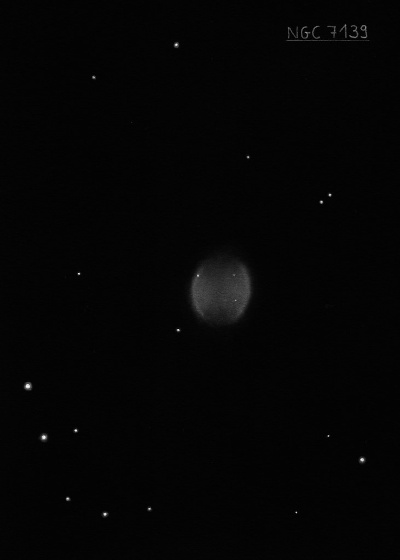
William Herschel discovered NGC 7139 = H III-696 on 5 Nov 1787 (sweep 775) and recorded "vF, iR, may be a patch of stars but I have not been out long enough, about 1' diam." His position is within 2' of this planetary. Four nights later (sweep 776) he reported "vF, S, R, lbM, r." On 15 Oct 1794 (sweep 1062), he noted "F, irr figure, easily resolvable." On this sweep, his position is just 1.3' too far south. John Herschel didn't record an observation. Bigourdan measured an accurate position on 24 July 1884.
Heber Curtis first found the spectrum to be of a planetary with a slitless spectrograph at Lick. Based on a Crossley photograph. Heber Curtis reported (1918) "the oval is 86"x67" in p.a. 20° +/-. Considerably fainter along the major axis; at the east and west edges slightly brighter streaks appear, indicating a ring or shell formation."
The declination is 8.5' too far south in the RNGC, Sky Catalogue 2000, Strausberg-ESO Catalogue, NGC 2000.0 and the first edition of the Uranometria 2000 Atlas. The position is correct in the NGC and the P-K catalogue. Kent Wallace was first to note the positional error.
200/250mm - 8" (8/28/81): extremely faint, moderately large, round, difficult, a faint star is near the south edge. Located about 4' NW of a faint curving arc of stars and 23' E of mag 7 SAO 19595. This is one of the faintest planetaries observed with the C8.
400/500mm - 17.5" (10/13/01): easily picked up sweeping at 100x without a filter. Appears moderately bright, round, 1.2' diameter, crisp-edged. A mag 13.5 star is off the SE edge. Excellent view at 280x without filter. The surface brightness appears irregular with a slightly brighter rim, particularly along the eastern half of the rim. An extremely faint star is intermittently visible right at the NE edge. A nice, elongated group of 6-8 stars follows the planetary in the same high power field. Central star not seen at 280x.
17.5" (8/8/91): moderately bright, fairly large, slightly elongated, 1.2' diameter. A mag 13.5 star is just off the SE edge 40" from the center. A slightly darker center is visible with an OIII filter at 140x but the annularity is subtle. No central star visible.
600/800mm - 24" (8/31/16): excellent contrast gain using a NPB filter at 200x. With this combination NGC 7139 is fairly bright, round, crisp-edged, 1.2' diameter. The rim is slightly brighter, particularly on the east and west sides and slightly weaker on part of the north and south rim, giving a subtle annularity. The interior is unevenly lit, and a bit darker on the north-northeast side. A mag 13.5 star is off the southeast end [0.9' from center] and a mag 15.5 star is right at the northeast edge of the rim.
Notes by Steve Gottlieb